- This topic has 98 replies, 3 voices, and was last updated 8 years, 3 months ago by
Giulio TiberinI .
-
AuthorPosts
-
15 August 2016 at 9:10 #8150
I never thought that the realization of a convex optical implying actions exactly contrary to the common rule, was the equivalent of playing cards that is called in Milan “Ciapa no”
 16 August 2016 at 23:40 #8156
16 August 2016 at 23:40 #8156Very Massimo…

Meanwhile, one of the two glasses is made…
Now comes the fun… 31 August 2016 at 14:47 #8244
31 August 2016 at 14:47 #8244It Mirco, the “bello” It is definitely arrived
 the convex work is really hard…
the convex work is really hard…However, we are close enough, about 1/2 Lambda final dall'iperbole.
During the early stages, I made a big mistake that gave me a generous edge retorted, a mistake that another evaluation, the wrong way “reason” .
I reasoned fact on the form, trying to assess areas over or under choirs, increasing or decreasing, as usually they tend to do it… when working with the fringes of Newton referred to a sample surface, you have to abandon the idea of the shape and reasoning on the distance ( physics ) between the two surfaces, Newton's fringes are to be read and so everything becomes easier ( at least in theory ).
The damage was still done, and now I am slowly reducing the extension of the edge retorted.
This is the situation at the time: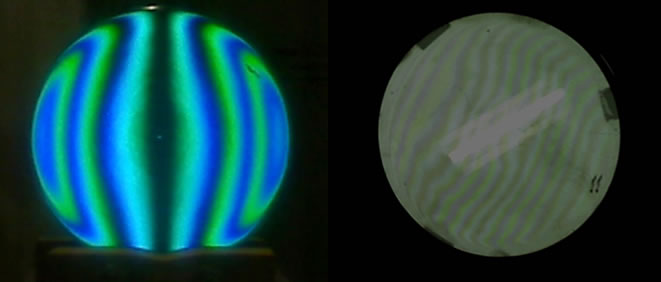
The Ronchi clearly, It is made “from behind”.
Fortunately, given that prevention is better than cure, the diameter of the mirror is of 10 mm “plentiful” than the secondary project, 115 mm Actual against 105 mm votes, which means that the board never reflect light but will always be covered by the hood ( for CPL expected ).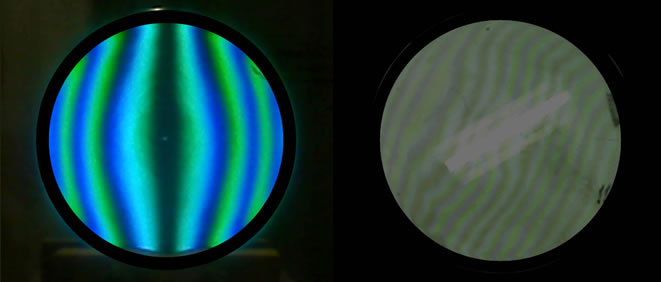
This is the useful surface of the mirror, then just still extend the correction for other 1 or 2 mm towards the edge, while you end up reaching the final hyperbole, which does not require a great job. ( at least I hope )
Regarding the fringes, indicate a maximum deviation of about 1/2 The lambda. Tracing a diameter intersects one fringe (dark ).
That which is “indefinable” are the small bumps along the same fringe, They could be irregularities but also the likes of the convex, most likely are the irregularities of the two surfaces that in some points are added and cancel each other in.
In fact, the analysis is not referring to a theoretical surface and therefore perfect, but at a caliber, Foucault analysis indicated a maximum deviation of 1/8 The lambda.
Assuming at some points of the convex also a similar deviation, there would be adding the two deviations in the opposite direction, an error of 1/4 The lambda, which roughly corresponds to the size of the small bumps visible on the fringes.
It is therefore difficult to understand how to intervene in “locale” , it is quite easy to evaluate the general performance of the single fringe, and understand where there is to remove glass and where not, it becomes difficult to try to “smooth” the fringes of irregularities, which refer to deviations on small areas, too small to try to intervene directly.
A help comes from Ronchi , Some of these irregularities are visible and you can correct , but in general, a completely straight without Newton's fringe “dossi”It does not mean that the surface is perfect, only that have been replicated perfectly all the errors of the gauge surface.
 1 September 2016 at 13:57 #8249
1 September 2016 at 13:57 #8249Small surface refinement interventions, the “drafts” They appear to decrease both on the slopes that run on Newton's fringes. It remains to be still regulate some’ the shape and retrieve another mm retorted edge.
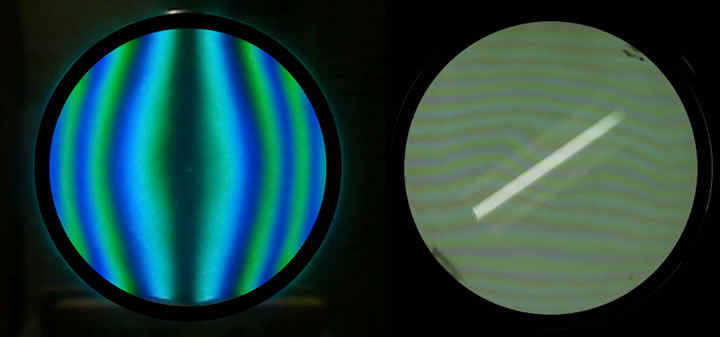
p.s. images are “diaframmate” the floor area of the project.
3 September 2016 at 19:44 #8254We are almost there… according to the interferometer “homemade”

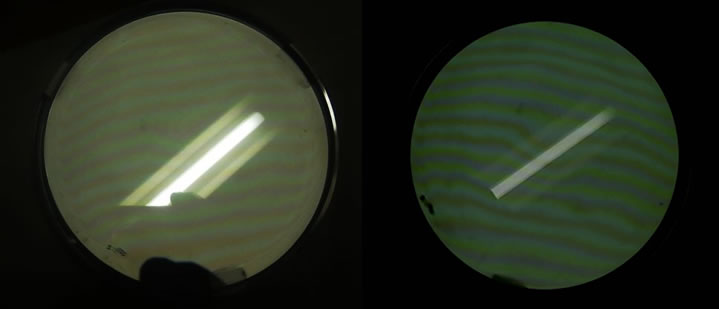
the image on the right is diaphragmed to the useful surface.
5 September 2016 at 9:27 #8259Good job!
The fact that the fringes are curves of a half lambda would think that it should be a sign that the surface (apart from the edge) It is already at this time to the desired tolerance.As for the small bumps, I think that what you think is the right diagnosis. On the other hand we lost it again, is your eye very attentive and trained to notice them.
But you see them making “a deeper evaluation and localized within that more extensive and specific Ronchi”; That is what I mean; acting in a way (certainly correct) equivalent to the evaluation of “half notches” between the divisions of the Foucault tester.Another excellent solution “biblical” (in the sense of the tips of optical books) is that of having chosen a secondary a little larger so that it may possibly diaphragm edge, which in this case it is even more difficult to achieve with respect to the plane mirror.
5 September 2016 at 11:12 #8261Thanks Giulio !
And, indeed, the edge is very difficult to work hyperbole convex,( on the ball no, it is “naturally” )This was known from the start being reported by many authors, it is also true that I have helped to make it even more difficult with some of my mistakes, from which the 5 mm riveted area, but precisely in anticipation of this and I remember how much I labored on the edge of my first 125 mm ( the most are small and most are terrible mirrors
 ), I preferred to keep me off.
), I preferred to keep me off.Now place the board would pure “accademia”, It could also do but in the end you do not need.
Yesterday , despite the hazy sky, I mounted the mirrors on “prototype”
 :
:a good time to try to coincide the three mirrors ( I also assembled the diagonal plan to have a more comfortable configuration Nasmyth, early photos ) without however being able to have a perfect alignment, another good time to try to put the right distance from secondary to primary, (just a mm of difference of this value to appreciably impair the image quality), at the end also with mirrors without alluminature, the brightest stars you see, Vega has allowed me to do well as a discrete star test and improve collimation.
I am very satisfied with the stars puntiformità eyepiece, does not seem to be aberrations, beautiful the fact that from one side of the visual field, the image of the star remains as such, indeed there seems to be the coma.
A more reliable test can be done after the aluminizing at least the primary, when the reflected light is too little and could hide the “moustache” too faint to be seen.
Therefore, before further work on the secondary aspect of a more clear evening or the aluminizing of the primary to make a star test together with a whole system Ronchi
5 September 2016 at 19:50 #8262How can well to contradict myself !

Another small correction, now, however, I will stop swear !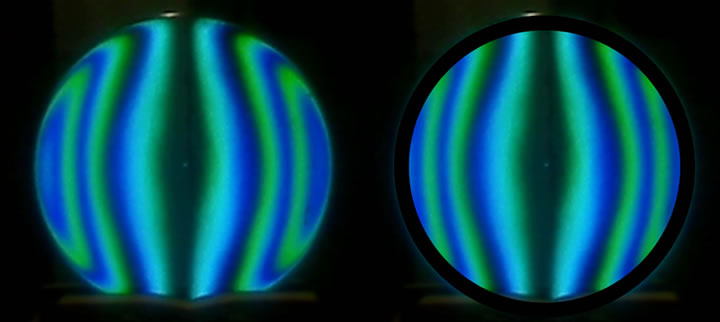
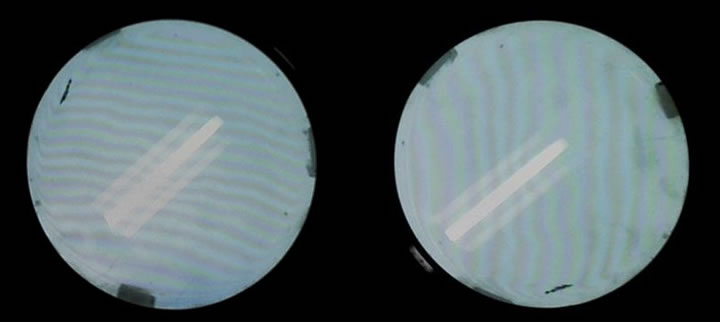 6 September 2016 at 14:40 #8268
6 September 2016 at 14:40 #8268complimentissimi Massimo…good job…
 6 September 2016 at 19:20 #8269
6 September 2016 at 19:20 #8269Thanks Mirco.

Also there “collinetta” the center of the fringe as I leave… in that area there is no reflection on the caliber and had been measured only the ROC of the center, the beginning and end of the hyperbole, but the first of couder mask area was from within 15 mm, then the diameter up to 30 mm è “unknown”, maybe that's the caliber defect… 7 September 2016 at 9:40 #8272
7 September 2016 at 9:40 #8272

 Beautiful work! I can well imagine your satisfaction!
Beautiful work! I can well imagine your satisfaction!At the level of gloss you've reached do not think it would improve the wet reflectivity mirrors, and I think it still, from now on you will be great satisfaction not yielding to the will to do ritocchini in hazardous areas.
For John Dobson experience, any residual imperfections are difficult percepimento in visual already in its rudimentary realizations…Imagine with the care and attention that you have invested in it!
(John in the popular movie, as Foucault test wets the mirror and looks at him with grazing to identify “steps” on surface; and then he makes a star final test on the reflection of the sun on suerficie curve of a high-voltage electric line insulator).
7 September 2016 at 11:09 #8273Thanks Giulio !
I think a few tweaks will still done on the basis of two new elements:1 -After positioning with precision the mirrors at the right distance, I measured the back focus and was 9 mm shorter than the project ( the telescope prototype is controlled accurately to mm in all its measures ).
It may seem a small thing, but I still investigating to see from what he could depend on this anomaly.Playing with software, the only possibility that this RC system in this arrangement, to form the fire 9 mm ahead of schedule, taking as the central fixed point of the secondary ROC of which are more than sure, It is that the primary has a focal ( and then a ROC at the center ) almost 1 mm less than that placed on the calculations. This thing we can stand, because I have always measured the ROC of the primary drilled in the vicinity of the hole, ever at the center of course seen that the center there …
Substituting the new ROC value of the primary, everything fits with precision to the nearest millimeter also moving away / approaching the mirrors and measuring the new backfocus.
This, however, would require a constant slightly higher conical secondary:-5,39 instead of -5.36. How this difference affects the quality ? I do not know, according to the simulations of very little software, the central spot has the same dimensions ( or just above ) of the Airy disk instead of being completely inside.
2-Yesterday I was able to make a star test with the necessary calm and telescope collimated: the picture looks good with diffraction rings that look almost equal in intensity and distribution in intra / extra focal.
The only fault I could find is a greater extension of the shadow of the secondary in intrafocale. Not by much, but perceptible.
This should mean a residue of spherical, quite right ? which seems in accordance with the request of a constant still insufficient conical part of the software.I also tried using the network of Ronchi instead of the eyepiece, the lines seem perfectly straight, but it must be said that the large spacing 2 lines / mm grating of my, can give no precise details, It would still not be able to detect a defect of this entity.
What it does in this case ?
 7 September 2016 at 20:36 #8282
7 September 2016 at 20:36 #8282In what progress I think it is advisable to take some time to reason about it. I confessso I'd be in big trouble deciding as long as I did not understand.
7 September 2016 at 22:02 #8284And, I also believe that it is the best thing
 13 September 2016 at 13:02 #8313
13 September 2016 at 13:02 #8313Then, numerous tests of star test in these evenings, with various tests of collimation and distances between the mirrors to seeking the perfect , all with the same outcome, so I can be fairly certain.
Star test with eyepiece 10 mm ( 225x, the best that I could with no mirrors, illuminated ):
-its Vega, Fire in the best seen so net the small circle of the Airy disk, surrounded by a small spread in brightness area concentric and irregular depending on the turbulence, which sometimes it narrows becoming more defined and overlaps the center and other seems to expand and move away, I had never seen the image of a star like this, I do not know what it means.. ( maybe they're being astigmatic
 ) moreover I do not see spikes
) moreover I do not see spikes 
-away from the fire circles diffraction are barely visible, But the seeing does not seem to affect much the image as is the case in the fire, allowing a more careful observation.
The wheels are smooth and uniformly defined in the transition from intra to extra-focal, then I would rule out the roughness and astigmatism problems.-Difficult if not impossible to assess the difference in brightness of the circles, then the concentration of energy that could highlight any zonal problems, mirrors, illuminated does not reflect very little light and I can not in this evaluation.
-The shadow of the secondary ( hood ) It appears more extended intrafocale , I was able to take stock and I'm pretty sure the extent of this difference, which indicates a residue of spherical, in this case a undercorrection .
How much is this spherical ? in the table below, the image that comes closest to what I see during the star-test is represented in the second row of Table B, Relative to clogged tools.
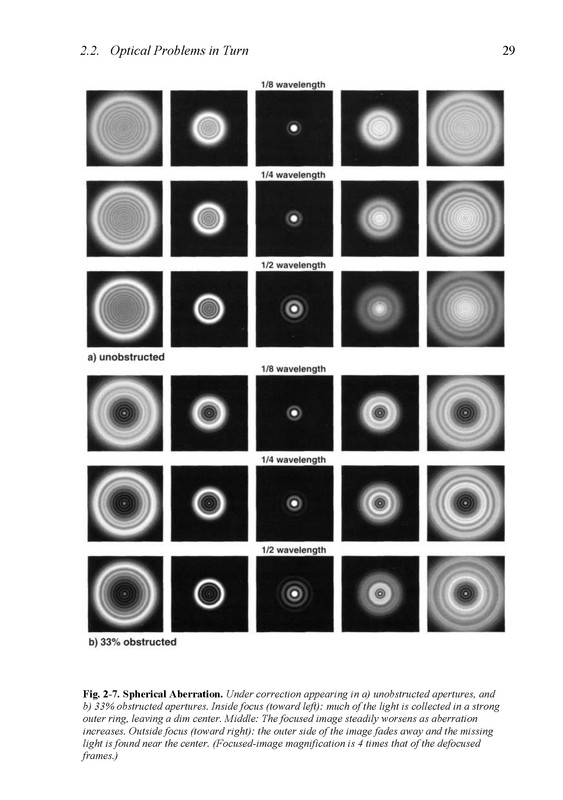
It must be mentioned that my configuration has a higher obstruction 33% shown in the table, the shadow of the secondary to me appear larger in both intra and extra-focal, but I believe that the difference between the two figures is more similar to the second line with respect to other.
So far, so good, the complication arises from the fact that moving away or approaching the mirrors, then introducing a spherical further that should add up or compensate for the existing one, the figure does not seem to change much, but it remains almost constant in the shadow extension difference.
I do not know how to interpret this thing, it is true that the shift between the mirrors is at most a few mm, but should be sufficient to alter the resulting overall quality of the system.
Then I asked myself: it would be possible for a spherical contribution is from the plane diagonal ( GSO from a simple 63 mm ) ?
“do a test without digaonale” you say
 … It is that I did not disassemble ( even if partially ) the prototype, readjust the focuser with a new support, again seek the center of the tube, collimation, etc, etc…
… It is that I did not disassemble ( even if partially ) the prototype, readjust the focuser with a new support, again seek the center of the tube, collimation, etc, etc… 
-
AuthorPosts
- You must be logged in to reply to this topic.